LP12MF Listening Test: Audio Desk Vinyl Cleaner Pro Ultrasonic
In this, my most ambitious Listening Test to date, I test whether the Audio Desk Vinyl Cleaner Pro ultrasonic cleaner makes records sound better. If you’re curious about how and why I bought the Audio Desk, and what exactly my cleaning system is, please check out my post “Washing Records with the Audio Desk Vinyl Cleaner Pro Ultrasonic and the Spin Clean.” This test is part of the LP12 Modification Frenzy, about which you can read more here. For a comparison of the effects of the Audio Desk to those of other upgrades, check out the “LP12MF Summary of Effects.”
tl;dr
This is a slightly unusual entry in the LP12MF. Whereas other rounds focus on physical upgrades to the LP12, this one focuses on a record cleaning system. Why? Because ultrasonic cleaning is supposed to make records sound better, just like any other upgrade. My favourite record blogger, London Jazz Collector, recommends thinking of the Audio Desk as a “component” rather than a record washing system. That’s the approach I’ve taken here.
This is also the most exhaustive test I’ve done yet. I went to these insane lengths, I think, because I had a hard time believing that ultrasonic cleaning could make as much of a difference as I seemed to be hearing. So I wanted to try it out a million ways to make sure I was really hearing what I thought I was hearing.
Here’s what I did, all of which is presented in detail below:
- I did my usual test-track procedure, where I compared ultrasonic-cleaned discs to the digital test tracks and noted any improvements compared to previous rounds (see “Test tracks” below)
- I did a neat little trick where I cleaned only one disc of double-LPs and looked for obvious difference in sound quality between the two discs, then compared when both discs were cleaned (see “Double LP Switcheroo” below)
- I compared the sound quality of one disc (Pet Sounds) after (a) a ultrasonic cleaning but no distilled water bath; (b) the same disc with a distilled bath; and (c) the same subjected to a second ultrasonic cleaning and distilled bath (see “Testing the effects of distilled baths and multiple washings” below).
- I did back-to-back listens to two particularly incredible-sounding records, first uncleaned and next cleaned in the Audio Desk (see “Before-and-after amazing-sounding records” below).
- I did more casual, background listening back-to-back tests with some more discs (see “Before-and-after whole-side semi-casual listening” below)
The conclusion of every one of these tests was the same: with two exceptions (both discs that already sounded very, very good), every disc sounded better after ultrasonic cleaning. I still don’t fully trust my own results, especially given that I have just shelled out a couple of thousand dollars for this machine and obviously want it work, both consciously and unconsciously. But I can only report what I heard with my own ears, in my increasingly ingenious tests. (I think the best of these tests was the “Double LP Switcheroo,” which is where I came closest to convincing myself.)
What was the improvement? There wasn’t just one thing; if you want to know all the effects on my many test discs, you’ll need to read on. But the overall impression is of increased clarity, improved separation between instruments, and more natural presentation. In several tracks, I had the sense that the whole soundstage had been rebalanced: not only were instruments set more clearly in space, but their relative volumes seemed to have been readjusted. The improvement was consistent across older discs and brand new ones. Indeed, if anything, brand new discs improved more markedly than older discs — it must be something that’s sprayed on new discs leaving the factory that either wasn’t on older discs or has been removed through years of use and/or previous washings. The Giles Martin remix of the White Album, for instance, sounded at least 10% better after being cleaned — and I bought it brand new a few months ago.
The average improvement on my test tracks was 5%, the same as the improvement for the Tiger Paw Khan top plate and less than the Mober subchassis. That sounds about right to me: the sound of a disc after cleaning is significantly better. London Jazz Collector’s idea that we should think of the Audio Desk as a “component” makes sense to me. (But the Audio Desk did cost several times more than either the Khan or the Mober subchassis, so it may offer less value for money.)
Another finding is that discs washed in the Audio Desk benefit from a follow-up rinse in distilled water. That adds some time to an otherwise fairly elegant and user-friendly experience. For photographic evidence backup of this listening-test result, see my companion post, “Washing Records with the Audio Desk Vinyl Cleaner Pro Ultrasonic and the Spin Clean.”
By the way, if you want to see (and hear — ugh!) the whole 13-minute procedure that I use on my dirtiest discs, here it is.
I’m really happy with the improvement in sound quality. The only bummer is that I now need to clean each of my thousands of records. It’ll take a while.
Notes on casual listening
Despite my professed (and, I swear, actual) cynicism, I immediately had the sense that things sounded incredible coming out of the Audio Desk.
Most notable in early testing were three discs that had never previously been cleaned, and which I subjected to a three-step Spin Clean Soap / Audio Desk / Spin Clean Distilled treatment. These were my friend Jared’s copies of Sun Ra’s Heliocentric Worlds Vol. 1, Prince Lasha’s and Sonny Simmons’s Firebirds, and (whoa, bird theme) the David Holland Quartet’s Conference of Birds. All of these sounded okay but not special before washing and absolutely incredible afterward. Firebirds might be the best-sounding record I’ve ever heard on my system, and the second track on Conference of Birds, “Q & A” is going to become the track I play to shock my friends when they come over (lots of super-realistic rattle sounds).
A bunch of previously cleaned records seemed to sound a little better. Among them were Mal Waldron’s The Quest and Mingus’s Mingus x 5. Some discs that have sounded amazing come out of the Audio Desk since are my 1959 first pressing of Ornette Coleman’s Tomorrow is the Question (it went in sounding great, but emerged as possibly the best-sounding record in my collection), Yasuaki Shimizu’s Kakashi (it improved as much as its labelmate Mariah; see below), and Roxy Music’s Avalon.
One disappointment was that surface noise didn’t seem to be much reduced in the records that had previously been cleaned with the Spin Clean. I was really hoping my copy of Blue Nile’s Hats would lose its little surface noises, but they’re still there. Same with discs like The Quest and Mingus x 5. My 1966 pressing of The Shape of Jazz to Come didn’t lose its surface noise, but did seem to sound a little better. One clear exception was the record washed in the video above, my blue label Prestige stereo pressing of Eric Dolphy’s Out There, which had an annoying background hiss (like the sound of recycled vinyl) that was significantly reduced after cleaning. Another was my Giles Martin Abbey Road, whose hyper-annoying right channel swish seemed to be a little bit lessened (and the album as a whole sounded a little better than I remembered).
Test tracks
Just one additional note before starting: every one of these Test Track discs had previously been cleaned with my two-step Spin Clean system (regular wash followed by distilled water bath) in the last months. They were all gleaming and free of dust. So any improvement is not an effect of cleaning in general, but of ultrasonic cleaning specifically.
1. The Beach Boys, “I Know There’s an Answer,” Pet Sounds (1966)
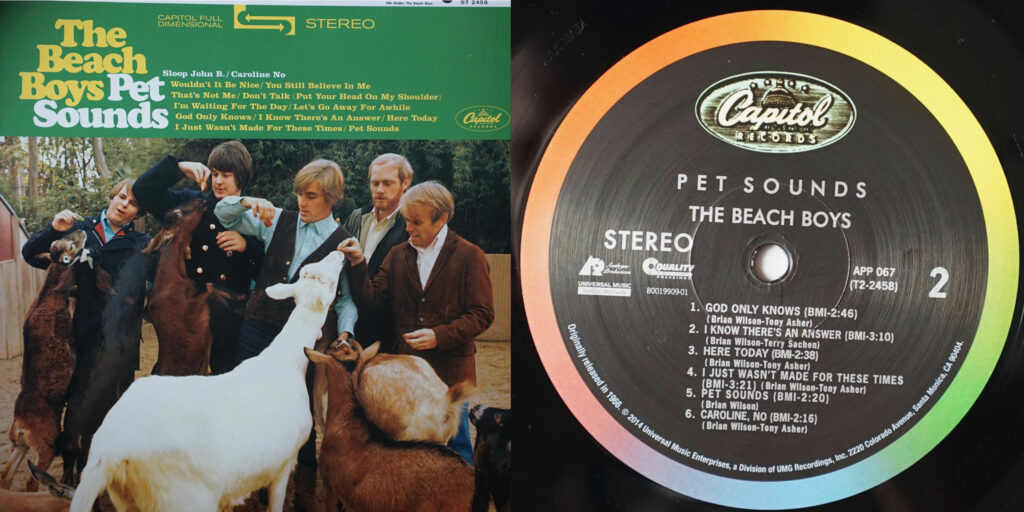
3 cycles, dried in machine (no droplets), no distilled water bath.
Full vinyl. This is the shortest time between tests — I did my last listening test less than a week ago — and I’ve been on a bit of a cleaning frenzy since I got this machine yesterday. I’m feeling a little jumpy with all the excitement (also: I’ve had a lot of work this weekend.) So I’m not exactly in a serene mood. But here goes. Very little surface noise between tracks (as it was before). Opening sounds really, really nice — shakers are very crisp and beautifully located in space. Brian’s voice is piercing in just the right way. Soundstage is wide — shaker to shaker. Bass goes low but I can feel the texture — it’s distinct. Bass harmonica is filled with nice detail — positively frothy. I could definitely take a bit more definition on the tympani at points — it feels faraway.
Full digital. My initial impression was of a bit of flatness/harshness — but then vocals came in and they sound terrific. Tympanis a little distant, but in the same way as the vinyl, I think. Nice texture on the bass here, too. My sense is that this is a bit behind vinyl, but not by much. What a great track, and this has to be one of the best-sounding digital files I’ve got on the test.
Slight delay. Definite flatness, background haze to the digital (despite usual level issues.) Heavier bass, more texture on harmonica and shakers.
S-2-s. Much more noticeable difference this round. More detail on shakers. Just a bit of a haze on digital. Not a blowout, but also very perceptible
Verdict: vinyl 10% better (5% improvement)
(Read below to see how this disc responded to further rinsing and cleaning in the Audio Desk.)
2. Charles Mingus, “Track B — Duet Solo Dancers,” The Black Saint and the Sinner Lady (1963)
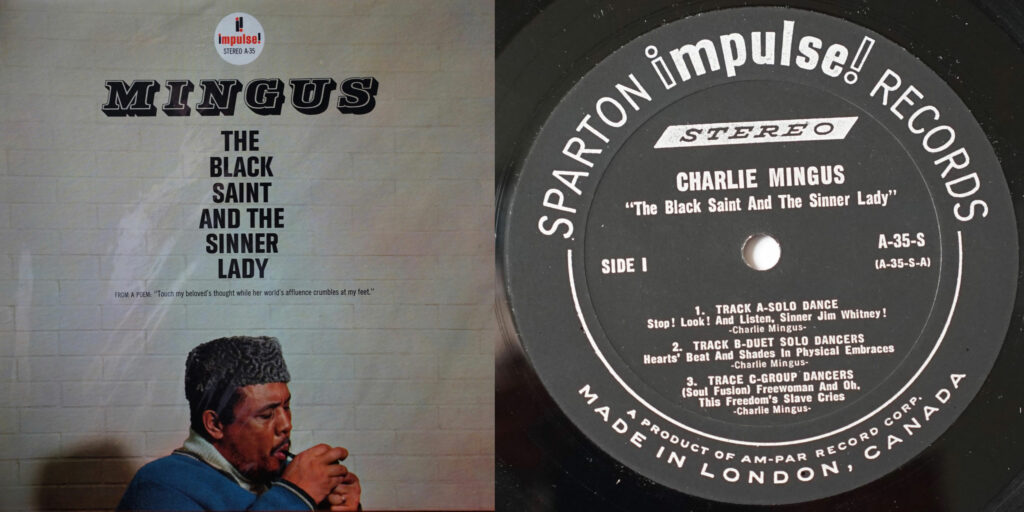
2 full washes, 4 cycles each, rinse with dry in machine.
Full digital. Obviously this is the comparison I’ve been most anticipating, since I suspect my vinyl copy might just be dirty and in need of a good ultrasonic cleaning. But good to get a digital baseline first. Sounds great — no complaints. Having had a taste of some really stupendous recordings lately on vinyl, I can of course imagine how this might sound a little better, especially in the cymbals, which can sound pretty tizzy. There is still a screechiness to the muted trumpets in the right channel that makes me want to turn things down. But it’s a great sounding file, no doubt. I remember listening to this a lot when I first got my Gungnir and really loving it, and I wasn’t crazy.
Full vinyl. The surface noise and the graininess are not gone. They don’t sound much reduced to me. Things definitely sound great, though, despite the persistent surface noise. The brushed hi-hat is wide and delicate, the buh-buh-buh-etc has lots of heft. The cymbals have nice decay and are nicely located in space. Beautiful texture to the “cordy” sax. Time for a direct comparison…
Slight delay. It’s very close — closer than last time, I think. But my sense is that digital still has the edge on lifelike presentation, especially of the brass. Drums sound a bit more natural in the quiet part on digital. I’m not sensing a breakthrough.
S-2-s. There are areas that digital excels: control and power. On details, vinyl is better in some ways, though, especially the ride cymbal, which is very tizzy on digital and much more natural on vinyl (though much more buried in the mix). At the end of the track, in the quiet drum part through to the end, vinyl seem to have a slight edge on naturalness. In calling this a “tie,” I am still trying to “hear past” surface noise a bit, I think. But I’d rather listen to the vinyl here, despite the noise.
Verdict: tie (5% improvement)
Vital vinyl S-2-s. Might as well compare my Vital Vinyl 2019 remaster (from a digital source). It’s huge, powerful, more detailed. Mastered with a lot more bass. Makes the vinyl sound grainy, as last time. Definite difference. Listening to the power-blast breakdowns and the quiet drums, I’m somewhere between 10% and 15%. So perhaps a slight improvement, but I think it’s closer to 10%.
Vital Vinyl verdict: vinyl in 10% better (no change)
NB: I’ve decided to buy another copy of this — a US second pressing in NM condition. It should get past the surface noise issues.
3. The Pentangle, “Let No Man Steal Your Thyme,” The Pentangle (1968)
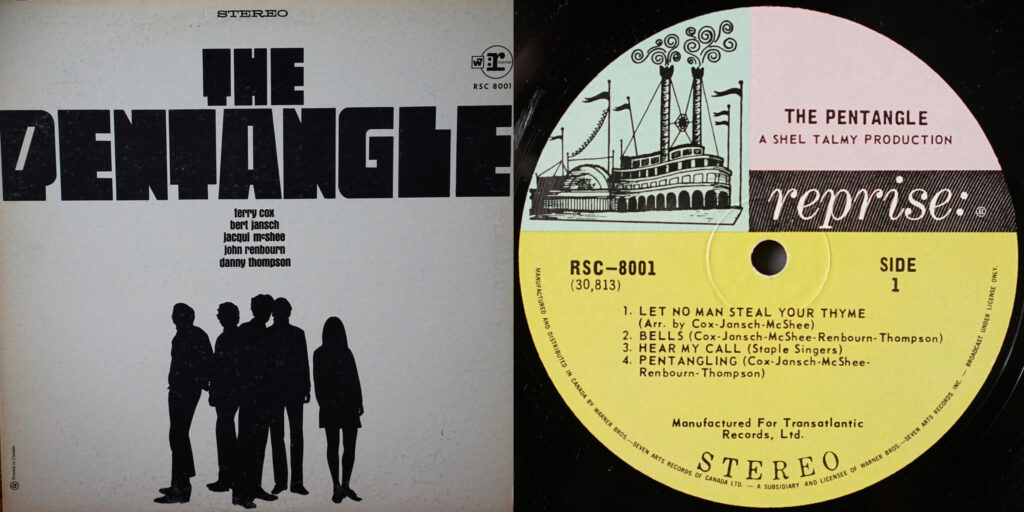
2 full washes, 4 cycles each, rinse with dry in machine.
Full vinyl. Still quite a bit of surface noise, still a sense of a “filter,” I think. Very nice percussive feel to the rim-hits or whatever those actually are (castanets?) Interested to hear how this sounds back to back, because it sounds pretty amazing here.
Full digital. Lovely sounds — bowed bass has a terrific rattle, Jacqui’s voice is beautifully clear and present. Acoustic guitars, too: natural, snappy, bright. In the quiet breakdown, the percussive rim-hit things are very good — equal to the vinyl, I suspect. Everything is nicely laid out in space.
Slight delay. Vinyl sounds great, lots of detail, very natural, but digital gives all that but will more focus, less clutter — and with no surface noise. More detail on digital. Both good, digital better.
S-2-s. Hmm, bizarrely, that all disappears on direct, second-to-second comparison. Yes, the surface noise is there, but vinyl has all the detail of digital, and a bit more detail around edges, a fuller, more balanced sound, more heft. Not just a volume thing. The digital sounds a bit harder and harsher. Vinyl win the second-to-second, though given the above comparisons, have to call this one a draw.
Verdict: tie (5% improvement)
NB: I’ve also decided to get a new, noise-free copy of this disc — a NM Transatlantic first pressing.
4. Mariah, “Shinzo No Tobira,” Utakata No Hibi (1983)
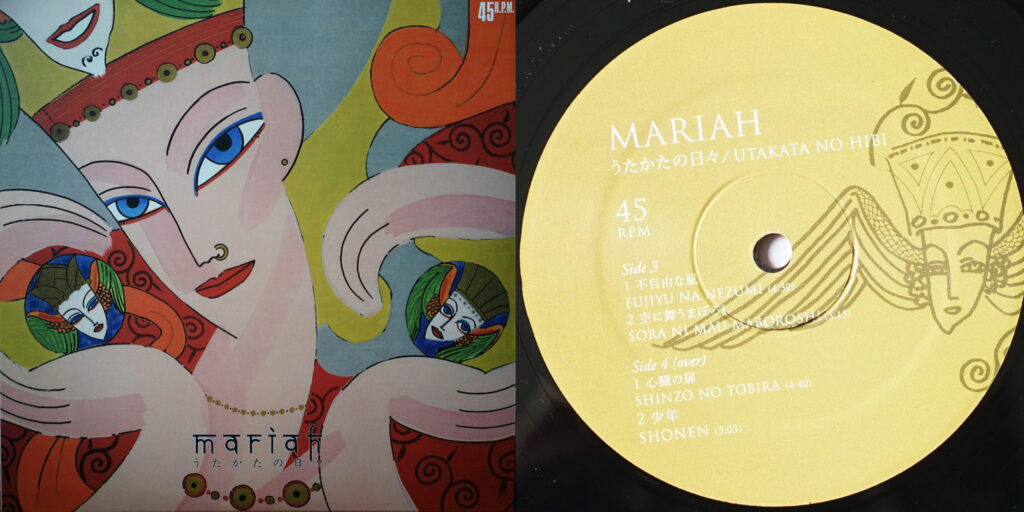
2 cycles, distilled water rinse
Full digital. Another of those times where I must ask myself, “Really: vinyl sounds so much better than this?” It sounds terrific: those delicate rattles, the huge bass, the goosebumps-inducing vocals. Definitely a pleasant listening experience that is making me excited to hear the vinyl, which I see from my notes was 10% better (halfway to “gross”) range! Brand new vinyl, so not expecting cleaning to make a difference, but you never know…
Full vinyl. Okay, those rattles really do sound a little crisper, higher-definition. The snare-like drum has plenty of impact and the bass lots of slam. I’m hearing lots of swirls and textures right in behind the vocal. Everything has beautifully defined edges. Definite sense that this sounds better.
Slight delay. Oh my goodness. That’s nuts. The detail and definition and “shading” on the rattles noises is miles apart. Flat, floppy on digital, sharp and in full relief on vinyl. SOOOOO much more impact on vinyl. With the voice at exactly the same volume level, I’m getting the bass and the rattles with what feels like twice the impact and presence. Big veil on the digital. I think we’re on the “gross” threshold here.
S-2-s. Huge difference in detail, slam, impact. Yep, we’re past the “gross” threshold. SO much clearer, real on vinyl. Cleaning has made a big difference. The only challenge here is getting the levels right, because of that weird effect where the same vocal level produces massively different loudness for surrounding instruments. Anyway, colossal win.
Verdict: vinyl sounds 20% better (10% improvement)
Now, for a harder test. This is a double LP. The other disc was washed with the Spin Clean but not with the Audio Desk. So the test now is to throw on the other disc and try to assess whether it sounds as good as the cleaned disc. Well, the songs are not the same, so it’s not an apples-to-apples comparisons. But I will immediately say that, on listening to the first track from side A, it totally does not seem to have the same rich detail as the music on the cleaned disc. I’ll repeat this with a few more double-LPs (see below), but for now, this feels like a pretty clear difference. Wow.
5. Joy Division, “Atmosphere,” 12″ single (1980)
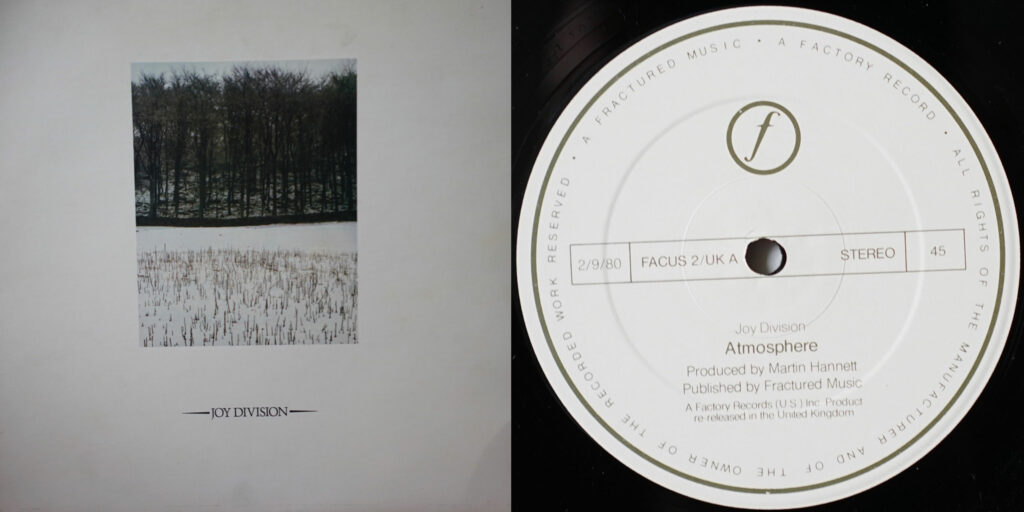
3 cycles, distilled bath.
Full digital. Okay, I know we were all the way up to a 25% difference last time. But this does still sound very nice on digital… even if I can’t help imagining rounder, more lifelike drums and more natural-sounding cymbals…
Full vinyl. Yowzer, the slam on those drums! Even more perceptible as a difference is the presence, detail, and loudness of the hand drums on the right channel, which really disappear on the digital. Sounds amazing, but need to move on to the comparisons…
Slight delay. Not a fair fight. Cloudy, narrow, confused soundstage on digital — dead clear on vinyl. The question is not which is better but how much. I wish I had a more solid way of distinguishing, say, 25% from 30%. It’s definitely beyond gross. It’s is beyond beyond gross? I don’t even know what that would mean.
S-2-s. I spent the whole time asking myself, 25% or 30%? But I’m not even sure what I’m asking — something to work on for these tracks that get miles ahead (solution suggested below: 30% is when the digital sounds appalling, like not just gross but actually horrifying). So I just switched to vinyl and listened to the rest of the track, which is just beautiful.
Verdict: vinyl is 25% better, at least (let’s say no change, just to be careful)
One funny note: I think there might be more “surface noise” here — which is actually not surface noise but some warp that is being translated into ticks by the cartridge. Not sure why this would show up more clearly with a cleaning, but it seems to be.
Just switched over to the other side, “She’s Lost Control,” which, wow, sounds better than I’ve ever heard it before, even if it’s not quite the production tour de force as “Atmosphere.”
6. Low, “Just Make It Stop,” The Invisible Way (2013)
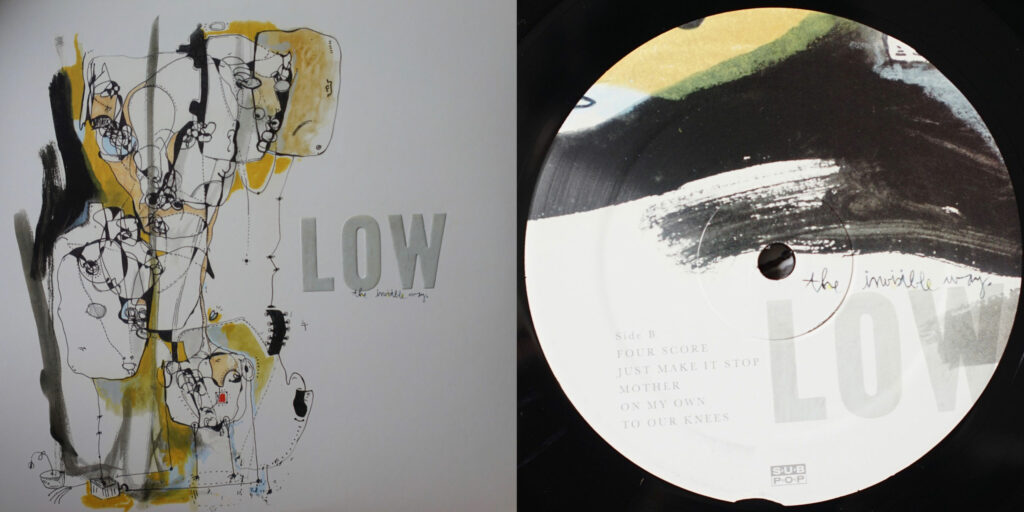
4 cycles, distilled bath.
Full vinyl. This is a disc that had some surface noise out of the box, and that doesn’t seemed to have been lessened. Really big, rich, full sound — is it bigger than before? This one got 4 cycles — it would be weird and disturbing if more cycles kill high end or something! (Note: from other listening tests, that doesn’t seem to be the case on any other disc.) Anyway, we’ll leave that for the direct comparisons. Sounds amazing, anyway — another distinctly pleasant listening experience, even if it’s not quite as mind-blowing as Joy Division.
Full digital. No, it seems like that “rich,” deep, bass-heavy sound is just in the track. A bit confused and muddy in the centre on digital, and the brushed cymbals sound plinky.
Slight delay. Yeah, crazy for detail, space, coherence, focus. Most noticeable are the brushed cymbals, which are one little point in space on digital but reverberate in a huge sphere of sound on vinyl. Mimi sounds like she has a cold on digital. Things are just HUGE, reverberating, deep, but somehow all in focus on vinyl. We’re unquestionably in “gross” territory here. Wow, the drums details way out on the right and left channel — its like the drums on the far left channel just aren’t in the track on digital.
S-2-s. Oh my god, the cymbal over Mimi’s voice in the opening — hardly perceptible on digital, like a halo covering her whole head on vinyl… No question we’re in gross territory here, but I’ll be considerate and just call it…
Verdict: vinyl is 20% better (5% improvement)
(For what it’s worth, I often listen to the next track after “Just Make It Stop,” because I only do three tracks per day, and this is the last of the session. As I listen to it now, working on these notes, there’s no doubt in my mind I’ve never heard it sound this good…)
7. Yo La Tengo, “Stockholm Syndrome,” I Can Feel the Heart Beating as One (1997)
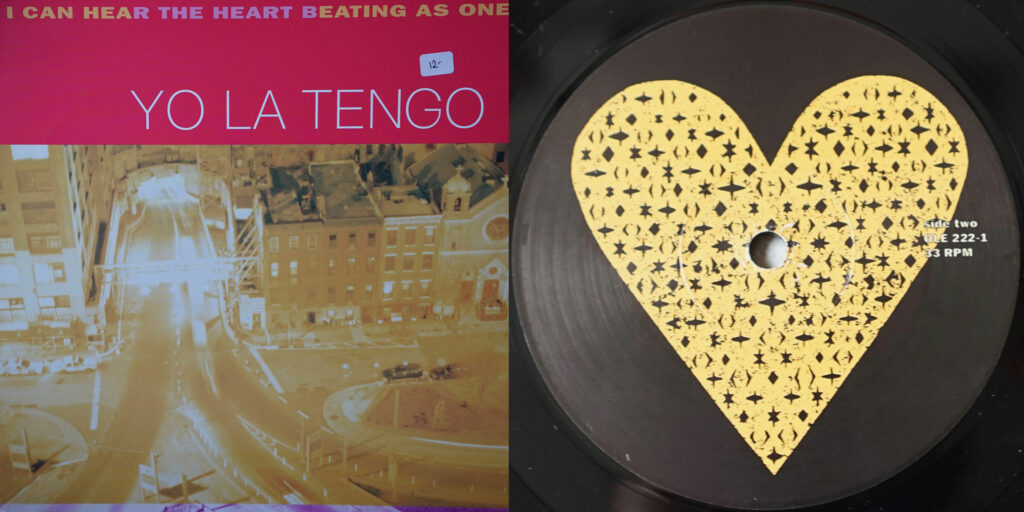
4 cycles, distilled bath
Full vinyl. No lessening of surface noise. Sounds amazing. Acoustic guitars as detailed as ever. Bass sounds maybe a bit buried, low in the mix? Generally speaking, not particularly “rich”-sounding… Drums sound amazingly present, real. (Whoa, drum into on next track sounds massive. Bigger than I remember.)
Full digital. I can immediately hear the lack of the detail, the dullness in the presentation compared with vinyl. Definitely much worse than vinyl. The bass that sounded “buried” in the mix on vinyl is almost inaudible here. Now for the tricky work of “gross” or “beyond gross.”
Slight delay. Wowwwwwwww. It’s really like a room filled with stale, hot, humid air — and then a huge door swings open and fresh air blows through the space. Definitely feels BEYOND GROSS.
S-2-s. I wish I had a more refined vocabulary for this, but it’s a tick or two beyond “gross.” Which seems better than last time. Here it’s matter of clarity, focus, separation. During the solo, the bass on digital is just a dull thud on the left channel; on vinyl, you can see it and almost feel it.
Verdict: Vinyl is 25% better (5% improvement)
This is a double album, and I didn’t wash the other one. So let’s switch over and see if things sound noticeable worse. (Different tracks, of course.) First track I listen to is “One PM Again,” in about the same spot on the disc as “Stockholm Syndrome,” and it does seem a little “heavy,” a little less focused. “Richer,” maybe, but more muffled. Obviously I’d want to clean it and see how it changes, but no time tonight. Still, I’d say the cleaned disc does sound better. (See more rigorous test below.)
8. The Beatles, “While My Guitar Gently Weeps,” The White Album (1968)
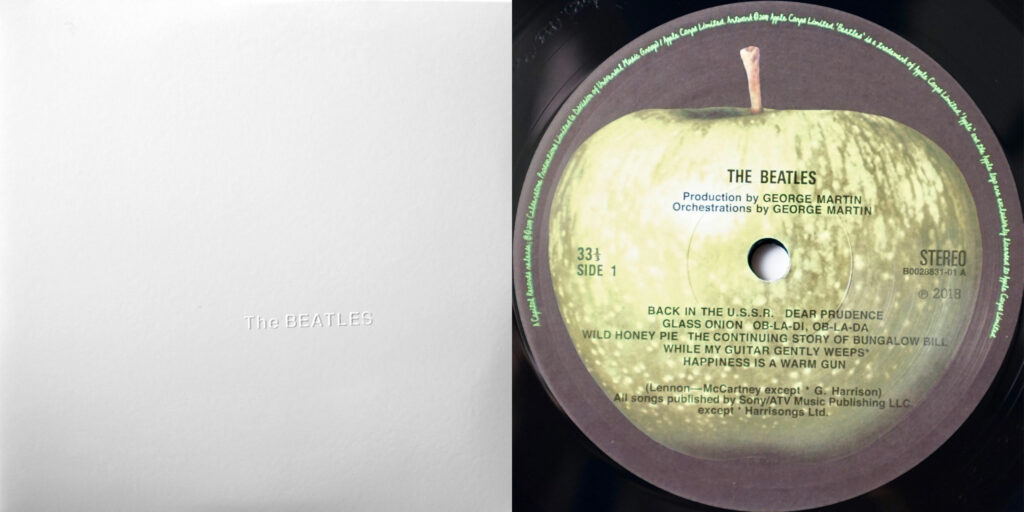
1 cycle, distilled bath
Full vinyl. Beautiful, full, hefty, wide, without any stridency. Clippety-clops and so clear I want to reach out and grab them. Strong sense of never having heard it sound this good.
Full digital. Immediate sense of less life, detail — and especially “heft.” Decay on the cymbal in the right channel on the opening is way off. The tone on the guitar and voice is weak and almost wobbly. Strong “gross” sense even in the back-to-back…
Slight delay. Man oh man. So much more heft, detail (especially on that opening cymbal), separation on vinyl. Just so much quiet, empty space between instruments. Unquestionably into gross territory here, maybe a step beyond. Unbelievable. Clarity, space, focus. Instead of one big, tiring chunk of sound, this whole room full of instruments, with air blowing through… Maybe 30% is “appalling” instead of gross. Are we there yet?
S-2-s. BEYOND GROSS. Appalling? No, I guess not. But this might be the clearest difference between two versions yet — well, maybe equal to “Atmosphere.” But I’ve never heard it like this before. And this on a 1-cycle cleaning on a new disc. AND, on a disc that is cut from a digital master.
Verdict: Vinyl is 25% better (10% improvement)
This too (as you may have heard) is a double album. Let’s see if another near-the-inside track from Disc Two sound this good… “Sexy Sadie” it is. And right away, nope, not even close, clearly much more muffled. Waynworse. (At least 10%). (See better test below.)
9. Dungen, “Panda,” Ta Det Lugnt (2004)
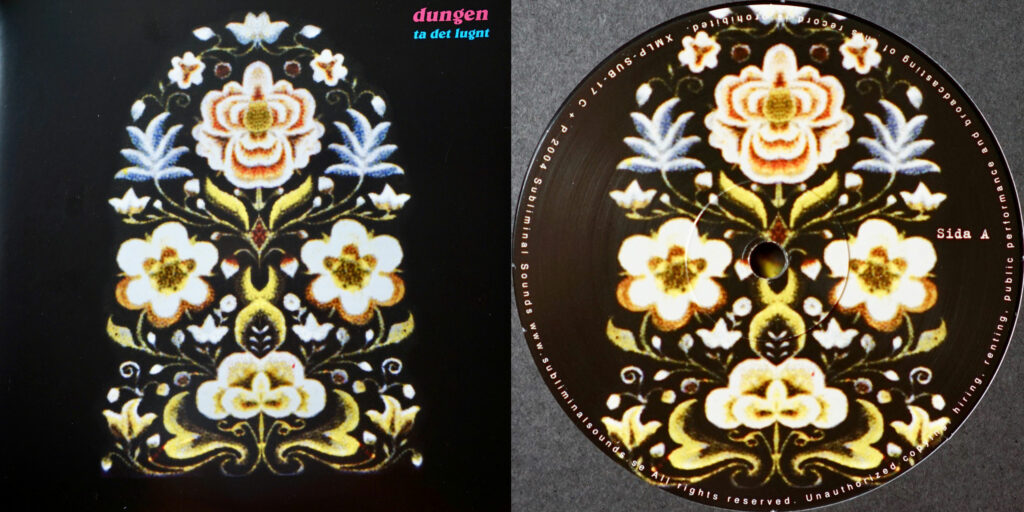
1 cycle, distilled bath.
Full digital. You know, those drums sound pretty damned good from the CD. This is just a really nicely-produced track. Definitely fun to listen to. If I didn’t know better… The more I listen, though, yes, the more I see the dullness, the harshness, the echoey corridors that I know will be opened up on vinyl.
Full vinyl. Is there any more beautiful sound than those opening drums on a good setup? And then the angry, crunchy guitars… And then things widen out and smooth out as the vocals enter. This sounds insanely good. So much punch, so much bite, so much detail, so much clarity between instruments. One cool thing is that I can totally tell when an instrument is meant to sound dull, as when the electric guitar on the left channel is clearly playing with a wah wah held all the way back, and then steps on it. Breakdown into sonic mushroom cloud is totally gorgeous.
Slight delay. Those drums! Very good on digital, INSANE on vinyl! So much more width, separation, the usual. I’m throwing my hands in the air with excitement (literally) listening to the vinyl. Is that a 30%? Even on the slight delay, I’d say we’re in gross-land.
S-2-s. BEYOND GROSS! Oh man. This just isn’t fair. Clarity, slam, detail, punch, everything. Unbelievable. Not “appalling,” just yet, but “beyond gross,” definitely. Clear improvement.
Verdict: vinyl is 25% better (5% improvement)
This is yet another double LP — though one where other tracks are noticeably not as well-produced as “Ta Det Lugnt.” But, for what it’s worth, the first track on side C does not stand out as sounding particularly excellent, especially the drums. (Didn’t put it in the “Double LP Switcheroo” test below due to inconsistent audio quality on CD.)
10. Julee Cruise, “Rocking Back Inside My Heart,” Floating Into the Night (1989)
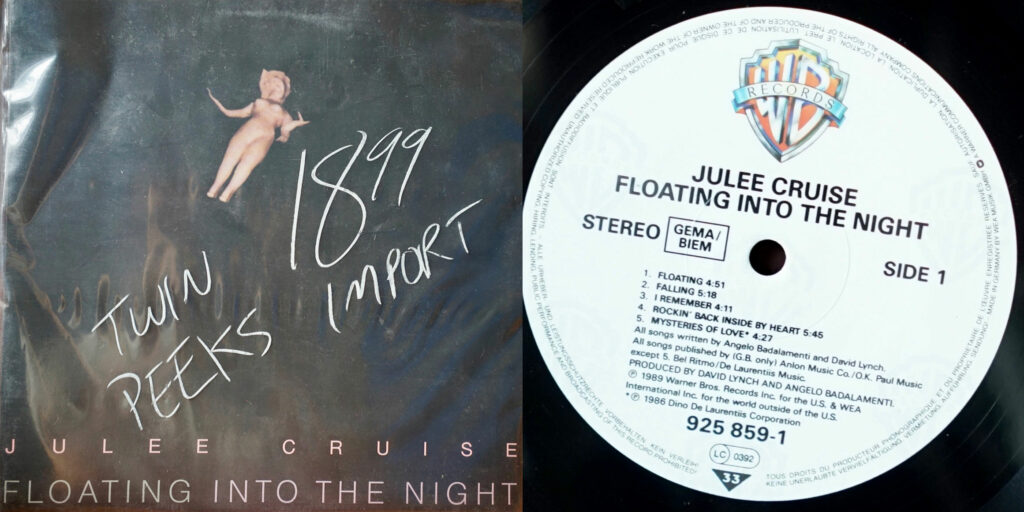
4 cycles, distilled.
Full vinyl. Wow. No surface noise, as before (as least we know the Audio Desk doesn’t add it). Incredible clarity and separation. Sax breakdown is incredibly wide and detailed.
Full digital. Really doesn’t sound bad, even after the vinyl sounding so good. I’m starting to think that my 30%+ will depend on obvious, night-and-day differences discernible from the full tracks, not just through A-B comparison. Okay, the sax breakdown does sound a lot worse here.
Slight delay. Same things discernible as last time: the palm mutes, the general clarity gap. Not sure the gap is any wider than last time. The sax breakdown, though, is crazy: sounds great on digital but AMAZING on vinyl, with so much width, bite, detail, texture. That strange effect is palpable again here: it’s like Julee Cruise’s vocals are floating above the mix, somehow, fully detached from the other instruments on vinyl. Maybe that’s the “3D depth” thing that people talk about? Definitely 20% (it’s not that the digital is “gross” so much as that the vinyl sounds incredible), maybe more.
S-2-s. Okay, I have the feeling it was really 15% with a 20% sax breakdown last time, and this time is more like a 20% but the sax breakdown sounds like 25%. I guess to be consistent I should call this 25%, but at the same time I don’t want to get involved in “grade inflation” here and leave myself no room to perceive improvements at later stages… But there’s no doubt, everywhere in the song, switching from vinyl to digital make me think “gross” (the colors disappear, the stage narrows, edges disappear). In the sax breakdown, the distinction in resolution, power, and impact is on another level. I’m going to say 20%, same as last time, though I’m confident this sounds a little better in comparison than it did last time….
Verdict: vinyl is 20% better (no change)
11. Can, “Halleluwah,” Tago Mago (1971)
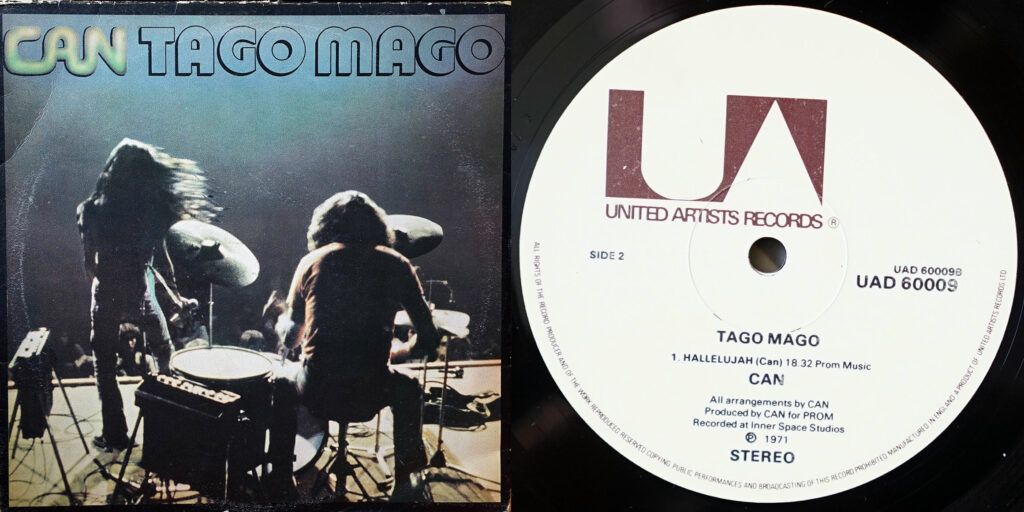
4 cycles, distilled bath.
Full vinyl. Same initial sense as last time, that in comparison with Julee Cruise this sounds a little flat. I think it’s the snare sound. When the first little drum freakout enters, things feel a lot more dynamic, but there’s still a certain flatness to the snare. Great impact on floor toms, amazing wide soundstage, synths and sound effects sit really clearly in the mix. Rattles are incredibly lifelike, as are the repeating synth textures that follow. Tickle sounds are super ticklish. By this point in the track, I’m no longer aware of any “flatness” in the drums — either because the flatness has gone away, or because the nicer-sounding Cruise record has retreated beyond the grasp of my audio memory.
Full digital. Wow, the digital sounds HORRIBLE after that. The problem isn’t so much “flatness” as fogginess (especially around the vocals) and a screechy quality to the cymbals. I know this is a track I’ve traditionally found really nicely produced/mastered on digital, but it sounds pretty gross here — and that’s in a full-song back-to-back. As I continue to listen, that “grossness effect” again begins to recede again, as it starts to sound decent — but there’s still a hardness to it, a confusion, a tiring, grating quality… It’s not so much a question of detail or impact but of tone. All the sounds are there and they hit pretty hard. They just don’t sound good. (Tickle sounds are hollow, distant… a joke.)
Slight delay. Jeez that sure does sound like “gross” right from the start. Vinyl is fuller with a much deeper low end, and all the trebly details are much sharper. Huge volume differential (which favors digital) is tough to overcome. Wow, the drum breakdown with the wide synth sounds is massssiiivvveeely nicer on vinyl: width and impact. Definitely, definitely in grossland here. Usual theme of this round: so much separation in the instruments, a strange rebalancing of the levels of the various instruments. The rattle sound is incredibly percussive on vinyl.
S-2-s. The opening few second on vinyl really don’t sound great. Then it gets amazing. But you know what? I’d hesitate to call this more than 15%. It’s significant, and it’s very close to “gross,” and the vinyl sounds so much fuller and more lifelike, but it’s not quite gross… The violin sounds around 7:00 are making we want to revise my verdict (eww, I got stuck on digital and wanted to get back to vinyl — definitely gross there!) — and, given my certainty above that this was a 20% situation, I guess I’d better go with that.
Verdict: vinyl is 20% better (5% improvement)
This is a double LP! How about the sounds on unwashed Side D? Nope: if anything, “Peking O” sounds BETTER. (I didn’t subject it to Double LP Switcheroo below because I suspect the whole second disc left the factory sounding better. It could even be that two discs from different pressings have ended up together somehow. The history of these UA early pressings of Tago Mago is incredibly confusing.)
12. Bill Callahan, “Javelin Unlanding,” Dream River (2013)
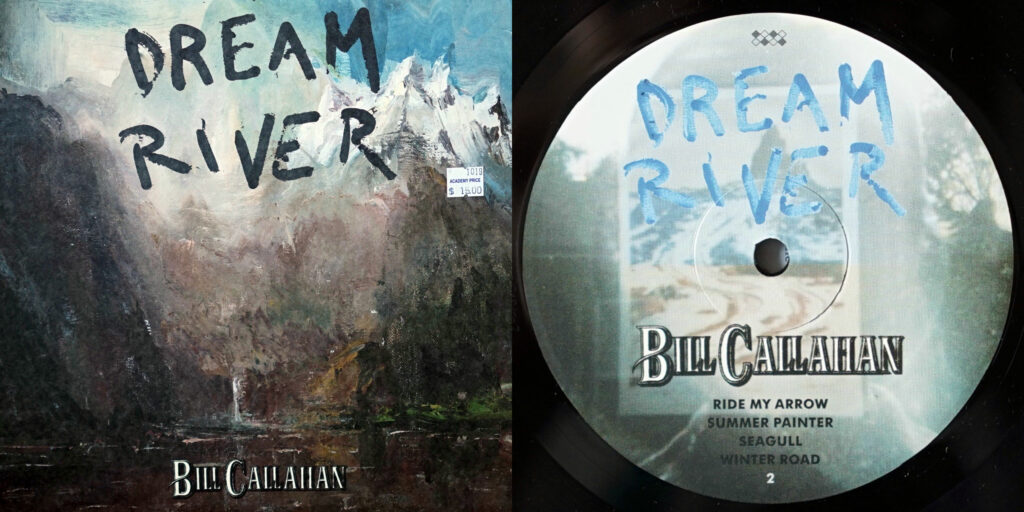
4 cycles, distilled bath.
Full digital. Although BC’s voice sounds nice and big, I see all the shortcomings noticed in previous rounds: mushy guitars, hazy soundstage, pixel-barf on the acoustic instruments.
Full vinyl. No lessening in the slight surface noise — geez that means that the Audio Desk didn’t improve surface noise on a single one of my test tracks. Soundstage much wider, BC’s vocals much clearer and more natural, beautiful detail on hand drums. The main things that stand out are super-natural percussion sounds and a nice chunky electric guitar in the right channel. Wouldn’t be surprised if this one is sounding better than last time in the direct comparisons.
Slight delay. Like last time, the difference feels “beyond gross” with the slight delay. Things are just so constrained and stuck together on digital. So much space and gentle detail on vinyl. And, yes, that new phenomenon of volumes not really being comparable anymore, because vocals seem to sit totally differently in the mix. Man, the vinyl just sounds so incredibly good, so real.
S-2-s. Maybe the biggest difference of any track here. It must be because there is so much space to begin with in this track, but switching from vinyl to digital is really beyond vomitty, like filling all the air with glue. It’s the little reverberations around the hand drums, the little rattling pockets of sound, that you miss most moving from vinyl to digital. Definite improvement over last round.
Verdict: vinyl is 25% better (5% improvement)
Double LP Switcheroo
Somewhere I remember reading someone cleverly evaluating record cleaners by cleaning only one disc of a double-LP and seeing if one disc sounded significantly better than the other. That idea came back to me as I was doing the above tests. So I decided to test this out more systematically.
The methodology is as follows:
- Pick tracks on different discs of 2LPs, but in a similar spot on the disc (inside/outside)
- Listen to the beginning of the two songs back to back (a) on digital, (b) on pairs of clean/uncleaned discs, (c) on pairs of cleaned/cleaned discs. Note only differences.
The expected pattern if the Audio Desk does what it claims should be that (a) both tracks sound the same, (b) the AD-washed disc sounds better than the unwashed, (c) they both sound equally good.
“While My Guitar Gently Weeps” vs. “Sexy Sadie” on The Beatles, The White Album (1968)

Disc one: 1 cycle, distilled bath. Disc two: never washed; then 1 cycle, distilled bath.
Digital. No obvious gap in sound quality between the two tracks. Both have deep bass and nice little details in the outer edges of the soundstage. John’s voice (“Sexy Sadie”) is slightly more nasal that George’s, so I won’t focus on that.
1 washed, 1 not. “Guitar” described au nauseam elsewhere; it sounds excellent. “Sexy Sadie” sounds a little worse — maybe not as obviously as I heard it the first time. Heavy, crowded soundstage, drums a little plodding. Cymbals and drums not particularly natural. Piano detail on the left crowded in the mix. But nice and forceful. We’ll now see if things are any different…
Both washed. Wow. “Sexy Sadie” sounds transformed. Heavy, crowded soundstage is lightened, spaced out. Drums and cymbals much more natural. Piano detail comes through very clearly. At least 10% better than before cleaning. Crazy.
“Shinzo No Tobira” vs “Sokokara” on Mariah, Utakata No Hibi (1983)

Disc one: washed with Spin Clean; then 2 cycles, distilled bath. Disc two: 2 cycles, distilled bath.
Digital. They both sound equally good, and are similarly based on cool drum sounds. There might be more going on in “Sokokara” if anything.
1 washed, 1 not. Definite “wow” level of sound quality for Shinzo, especially the snap and detail of the rattles on the edge of the soundstage. Definitely NOT “wow” for “Sokokara.” Duller drums, not anywhere near the same snap. Still sounds good, especially the spaciousness of the synths, but the impact is much less than on “Shinzo.”
Both washed. We’re in “wow” territory on both, now. No joke, no exaggeration, this is night and day. Tons of impact, snap. “Sokokara” went from sounding very noticeably worse to sounding totally equally thrilling — and actually maybe even better than “Shinzo” (a bit more happening on the soundstage). This is definitely the clearest test I’ve come up with for evaluating the Audio Desk. And it’s super impressive. I’m glad I bought it. (But, man, I have a lot of records to clean…) Wow, this track sounds unbelievable. One of the nicest I’ve heard on my system… (Can’t wait to clean my copy of Kakashi, released by the same label… [Note: I later did, and it too improved dramatically.])
“Stockholm Syndrome” vs “One PM Again” on I Can Feel the Heart Beating as One (1997)

Disc one: 4 cycles, distilled bath. Disc two: Spin Clean; then 1 cycle, distilled bath.
Let’s try something a little different. Disc one got 4 cycles. Let’s try Disc two with one cycle and see if that brings it up to the same level. And, if not, give it another 3 cycles…
Digital. Both sound a little gross to me, knowing how amazing “Stockholm” has been sounding on vinyl and having just listened to “Sokokara.” But they’re at the same level of sound quality.
1 washed, 1 not. A bit of surface noise on the lead-in. “One PM” sounds pretty good, not miles away from “Stockholm,” but the cymbals are maybe a splashy. but Ira’s voice sounds nice and round and there’s lots of nice echoey space on the left channel. Not a particularly wide soundstage. Worth noting: next song, “The Lie and How We Told It,” sounds really really nice pre-cleaning — would’ve been a good test track, rich and wide, with lots happening in the mix. This whole side actually sounds pretty terrific. “Green Arrow” is ridiculously nice, especially the round, defined bass sound. Maybe this’ll come out sounding worse! Only the shakers could use a little bit more splash…
Both washed — but now 4 cycles (“Stockholm”) vs 1 cycle (“One PM”). What do you know — less surface noise! “One PM” is definitely improved, and definitely sounds every bit as good as “Stockholm.” Cymbals are beautiful, lots of space. The echoey space on the left is bigger, wider. “The Lie” sounds unbelievably, with little details I wasn’t catching last time. Really rich, deep song. Definite improvement, and it only took one cycle. “Green Arrow” sounds stupendous, and yeah, clearly just that little bit better. For clean discs, it seems one cycle is enough (I mean, that’s what the manufacturers recommend, so does make sense…)
In conclusion, the Double LP Switcheroo strongly suggests that the Audio Desk makes a noticeable improvement in audio quality.
Testing the effects of distilled baths and multiple washings
The test track from The Beach Boys’s Pet Sounds was 10% better after one three-cycle Audio Desk cleaning and no distilled bath. So let’s see if it gets any better with a distilled water bath and a second full run through the Audio Desk. I’ll focus on a different track, “Wouldn’t It Be Nice?,” to reduce my boredom.
Methodology:
- Listen to the record as it is, comparing against the digital version in a second-to-second comparison.
- Give the record a distilled water bath in the Spin Clean, wipe dry, dry fully in Audio Desk. Return and do another S-2-s comparison.
- Give the record a full 3-cycle cleaning in the AD, a distilled bath, a dry in the AD. Return and do the next S-2-s.
The Beach Boys, “Wouldn’t It Be Nice?,” Pet Sounds (1966)

S-2-s with disc in current stage (washed once, 3 cycles, no distilled bath). Drums on left channel way more natural on vinyl. Grating, screechy quality to vocals on digital. Not massive differences, though. That “filter” is there, but not close to “gross” territory here. 10% is totally right.
S-2-s, after a distilled bath. Definitely a little better! Especially noticeable in the punch of the drums. I would have rated this at 15% better. Not “gross” but clearly better sounding than before the distilled bath. So that settles that: distilled baths are worth the trouble. (The difference is clearer still on “You Still Believe in Me,” where the little hand-cymbals and the clavichord are the main differentiators. Close to 20% here.)
S-2-s, after three more cycles and another distilled bath. No difference I can hear. Still at that 15% range, clearly better than digital but not “gross,” mostly noticeable in the “glare” of the digital and the punch of the drums. No difference in the (very minimal) surface noise. So, yes: more is not better in terms of cleanings, but the distilled bath is good. (On “You Still Believe,” that big, 20%-ish difference is still there, but no further.)
Lesson: Distilled water baths are good. No noticeable improvement on giving a second ultrasonic cleaning to an already cleaned disc.
Before-and-after amazing-sounding records
Here I take the two best-sounding records I have around (both loaners) and see what difference ultrasonic cleaning makes. Can an insanely nice-sounding record sound even better?
Methodology:
- Listen to a track (or two tracks), take notes
- Go to the Audio Desk, clean the disc, give it a distilled bath and wipe dry with cloth, dry fully back in the Audio Desk (about 10 minutes total)
- Listen to the cleaned track, with the volume knob in exactly the same spot. Take notes.
Anthony Williams, Life Time (1963, Blue Note BST 84180)
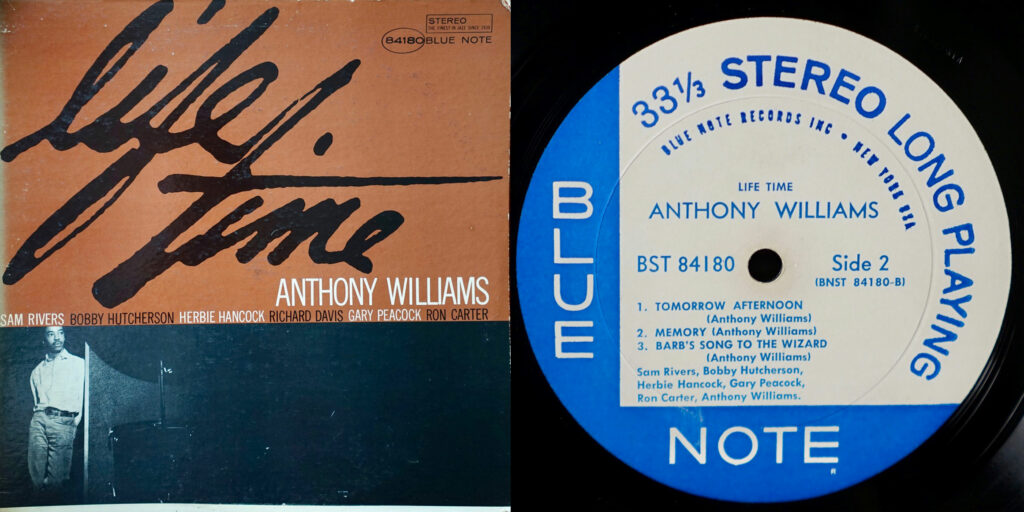
This is the only disc I have around that has all the Blue Note quality markers: a VAN GELDER stamp, a Plastylite “ear,” a New York label. (Okay, the one thing it’s missing is the “deep groove.” Close enough). This is on loan from my friend Jared. As far as I know, it’s never been washed, but it’s in terrific shape (EX or VG++) with terrific sound and little distracting surface noise. I’m listening to the first two tracks on side 2 (“Tomorrow Afternoon” and “Memory”), which sound particularly great.
Before cleaning. This is a bright-sounding record. It’s the cymbals that sound particularly amazing on “Tomorrow Afternoon”: bright, present, full of life, and very percussive, so that you can really feel the stick hit the cymbal. There is some noticeable surface noise in the quiet parts. Could anything be better? The surface noise could go away, the sax could be a little bit more present, the bass could be a little less “thuddy.” The second track, “Memory” is the real audiophile tour-de-force. Okay, there is some distortion on the shakers at the start — maybe that’ll go away a bit. The vibes sound amazing: right there, so that when you close your eyes and open them again you’re surprised they’re not there. When he’s hitting them (muted?) so that they sound like little anvils — that sound is insane. The deep, quiet drum on the right at the start is subtle and great, and then the cymbals super alive. It’s going to be hard to know if something this good can sound better. My sense listening to this is that it sounds amazing, and at times incredibly real. But I could imagine how it might sound better. How? No surface noise would be nice, lessened distortion on the shakers, maybe a bit more of a delicate splash on the cymbals — more of the radiation in space…
4 cycles, distilled bath. Now it’s the sax that stands out as sounding particularly great on “Tomorrow Afternoon,” not the cymbals (although they sound terrific). Still bright but less aggressively so maybe? Same amazing percussive effect on the cymbals, but definitely, all my attention is now on the sax, which wasn’t true on the last listen. The surface noise has been significantly reduced (remember that I had not previously washed this on my Spin Clean system, as I had with all the above records). No “thuddy” feeling on the bass at all. No doubt about it, “Tomorrow Afternoon” is sounding better post-cleaning. As for “Memory”: the distortion is still there on the shakers at the start. Surface noise is reduced. The deep, subtle drum on the right channel is more perceptible post-cleaning. There might be a little more “delicate splash” on the cymbals, but the difference is minor. I think the “anvil” sound might sound a little better (wowww). Wood block sounds are shockingly lifelike, again maybe just a wee bit better than before. The difference on “Tomorrow Afternoon” is definitely noticeable — on the very spare “Memory,” not so much. But still, around a 5% overall improvement, I’d say. Not a game-changer, but noticeable.
The Prince Lasha Quintet, The Cry! (1963, Contemporary S7610)
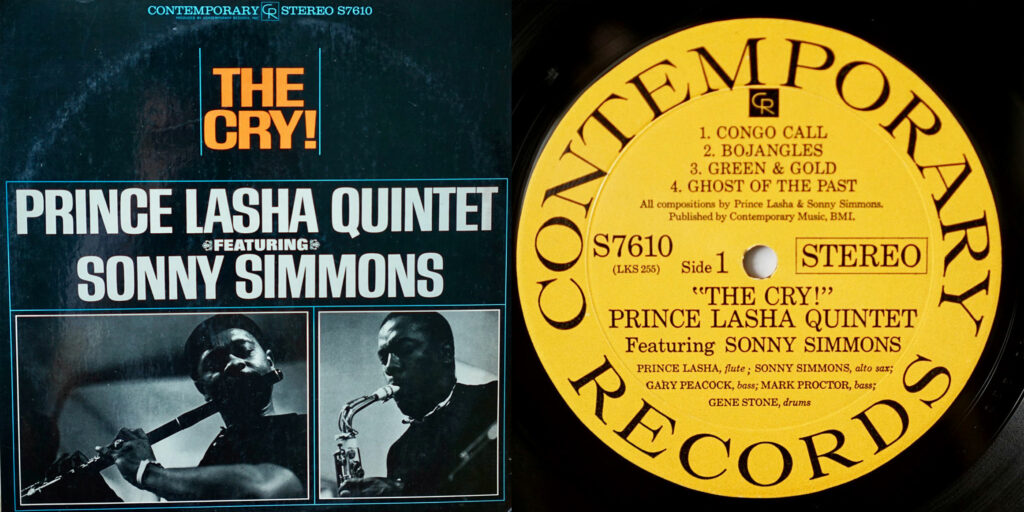
Man I love this record. I keep going back to it as the best combination of shockingly beautiful sound and incredible music. This is the US second issue, with the yellow Contemporary labels and the “H” stamp. It has D3 in the dead wax, indicating a third-generation stamper. This is another of Jared’s records. It’s in VG+ condition, with clean, shiny vinyl but a very slight warp on the first 30 or so seconds of track 1. It’s a little dusty and as far as I know has never been cleaned. I’ll only listen to the first track, “Congo Call.”
Before cleaning. The warp produces some annoying sounds for the first little bit, but the stunning sound comes through anyway. This is all about texture, space, natural instruments. Especially the two basses, bright on the left and duller on the right, but both producing incredible texture. Prince Lasha’s flute soars and warbles. As good as it sounds, and as great as the music is, it’s not as nice from a pure sound quality perspective as the Anthony Williams disc: the instruments aren’t quite as lifelike, aren’t quite “popping” to the same extent. The hi-hat is just slightly tinny, the drums just a little hollow, splatty. So I can imagine how it might sound slightly better.
3 cycles, distilled bath. Wow. It totally sounds better. More snap and texture on everything. More life on an already insanely lively record. Everything is popping. Not sure this is quite as good as Anthony Williams, but amazing and clearly a little better than before. The splattiness on the hi-hat is still there, but surrounded by all these little micro-details, so that it’s clearly just the splattiness of the actual hi-hat.
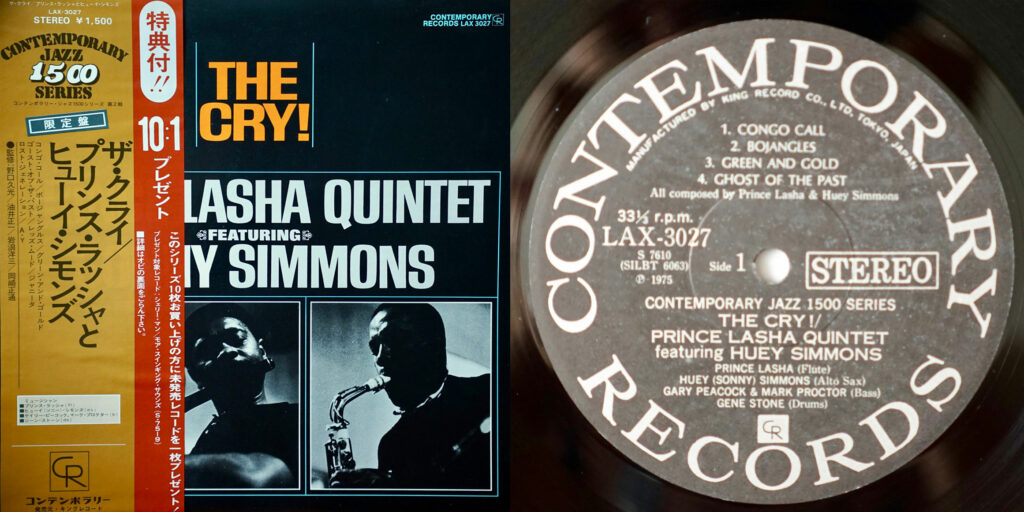
Now, for fun, let’s listen to my own Japanese pressing of this record, which just happens to have arrived in the mail today. It’s totally mint and appears unplayed. It’s made by King Records, so the sound quality should be good but the mastering will be different. As far as I know, it’s never been washed. I’ve never heard it…
Before cleaning. Dead quiet vinyl. I think a little less texture on the basses than in the US pressing. Definitely a little less bright. The sax and flute don’t seem to be popping like they did on the cleaned US pressing. I think in mastering they’ve added reverb on the whole track? Gross. Nice wide soundstage, but less impact due to the reverb. The cymbals might be even more clear and delicate than on the US pressing, and the drums a little rounder and clearer, too. Don’t get me wrong, this sounds really good, but overall a little worse than the US pressing, with less life and that annoying reverb. Let me listen again to the US to confirm all this: cymbals a little rougher, overall brighter presentation, more “pop” on flute — while there is some reverb, there’s less. The drums and cymbals come through a bit more clearly on the Japanese pressing, but the reverb and the less trebly presentation make it less natural than the US overall.
1 cycle, distilled bath. Aaaaah, the ultrasonic cleaner does it again! Everything wakes up, comes to life. The reverb on the flute is even clearer and even more annoying, but the whole track has otherwise just opened up and sounds as wide and lively as the cleaned US pressing. All the drum sounds are amazing, smooth, detailed, no flatness (except the in-the-instrument flatness of that hi-hat). Let’s compare to the US just to make sure I’m not imagining things… I prefer the slightly brighter, drier, less-reverbed presentation of the US pressing, definitely, but the sound quality of the Japanese is also amazing, if less forward. Would I buy a US pressing if I came across one? Well, yes, probably.
Conclusion: more evidence that the Audio Desk improves sound quality.
Before-and-after whole-side semi-casual listening
The methodology here is as follows:
- Listen to a whole side (while reading — couldn’t waste a whole day on this)
- Then go to the Audio Desk: clean the disc, dry the disc (takes about 5-10 minutes, depending on number of cycles and whether there’s a distilled bath)
- Then go straight back and listen to the whole side, cleaned — with the volume knob in exactly the same spot.
Charles Mingus, Mingus Ah Um (1959, Columbia Canada, CS 8171)
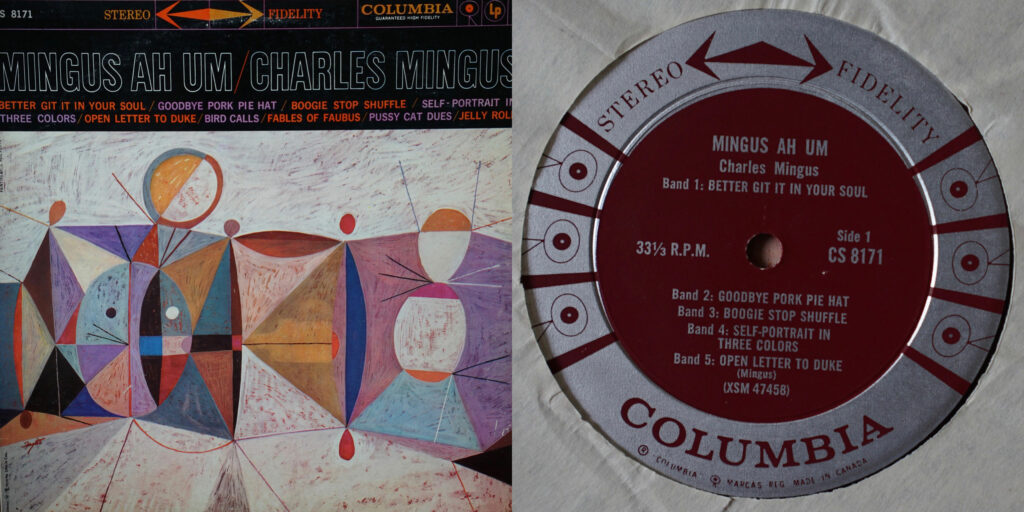
This one was really dirty when I rescued it from a friend’s shelf. But then I washed it twice with double Spin Clean system. Visually, a bit cloudy with lots of superficial scratches — a VG.
Before ultrasonic. Some surface noise throughout. A sense of a thin, slightly trebly, hollow soundstage, though the instruments sound beautifully natural. Brightness and hollowness are the problems. Not an exceptionally nice-sounding disc. Bowed bass/cello/whatever is really nice, despite thinness. Distortion in louder parts, especially noticeable in “Goodbye Pork Pie Hat.” Lots of noise/distortion on the last track on Side A. Loud surface noise in the dead wax.
Washed 5 cycles, no bath (came out totally dry). No question, sounds different (and better). Still some surface noise, not reduced much. But the instruments are louder, less thin, much more clearly presented in the soundstage. Significant improvement — 10% or so. Everything has opened up remarkably. Less distortion in loud passages.
Did a distilled water bath (three turns each way in the Spin Clean, wiped off, back in the Audio Desk for a dry cycle). Geez, this is hard to tell. Does it sound even better? Surface noise doesn’t seem to be much reduced. But I do have the sense that it sounds even better, particularly in cymbal sounds dead centre. Not night-and-day or anything, and very hard to verify, obviously. But since the first step, this has obviously gotten much better-sounding. Would absolutely not describe this as “thin” anymore. Much reduced distortion during loud parts. I’m pretty astounded at how good this sounds, and how much better. I won’t feel too bad if I can’t to a distilled bath, but I’ll do one if I’m not in a hurry.
Terumasa Hino Quintet, Live! (1971, Three Blind Mice, TBM-17)
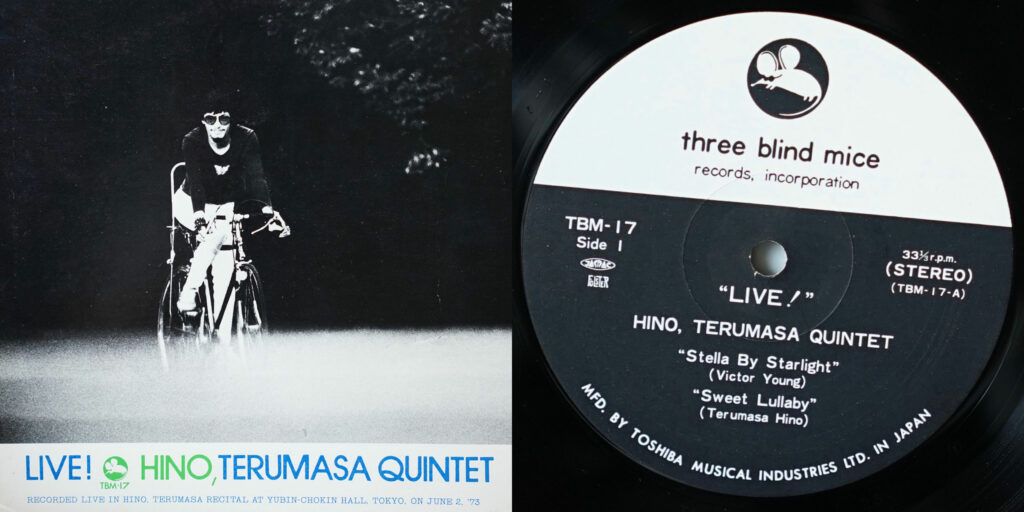
Never washed, but in NM condition, with shiny, immaculate, dust-free vinyl.
Before ultrasonic. Stunning-sounding record with incredibly wide soundstage, lots of very gentle little details in the opening: hand drums, bells, something that sounds like someone knocking a brass hammer on an anvil. Then a super piercing trumpet dead-centre. There is some quiet surface noise throughout, mostly probably because it’s so quiet. This is definitely a “reference-quality” album. Maybe the cymbals could be a little more natural, the bass a little more clearly positioned in space. The soundstage might get a little confused in the wilder parts.
Washed 1 cycle, with bath (initially came out slightly wet around edges). Less surface noise, I think. Sounds great, not noticeably better (or louder) just yet. Once the rattles start, it does sound better and louder — but obviously audio memory is hard. In the busy parts, instruments seem better separated. Rim hits more distinct, definitely. I think the bass stands out a little more clearly. Not nearly as clearcut as Mingus, but a noticeable improvement — 5% or so.
The Go-Betweens, The Friends of Rachel Worth (2000, Clearspot, CS 035)
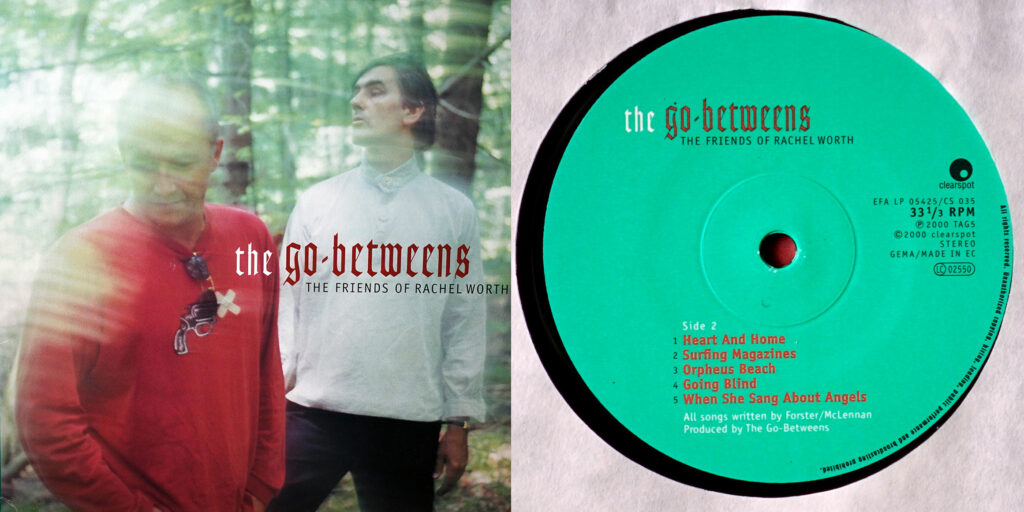
Previously washed using Spin Clean double system. Shiny, immaculate, NM.
Before ultrasonic. Really nice acoustic sounds on “Heart and Home,” but a bit of fog around Grant’s voice and the bass is a little muffled, nothing special about the drums. Only very minor surface noise. “Surfing Magazines,” one of my favourite songs of all time: sounds pretty good, nut nothing especially great about the drums or bass. Kick drum on “Orpheus Beach” sounds great… “When She Sang About Angels” is maybe the nicest-sounding here: really nicely recorded acoustic guitars on the right and left, a good sense of musicians in a room. Bass a little indistinct and some sibilance issues.
Washed 2 cycles, distilled bath, dried in AD. No fog around Grant’s voice, bass still a little buried, drums nice and clear with terrific cymbals. Definitely sense of improvement. Nice details I didn’t notice before, like fretting squeaks on acoustic guitar strings. Wow, synths sound great. An “okay” recording now sounds definitely “good.” Yep, wow, the drums now sound great in “Surfing Magazines” — nice dry snare rattle I absolutely wasn’t picking up before. That kick drum in “Orpheus Beach” sounds amazing, maybe better, hard to know… But there’s no doubt that everything else in the song sounds much better. “Angels” sounds less obviously better but obviously very good. No doubt of significant improvement on this disc.
Miles David, Kind of Blue (1959, Columbia; 1968, CBS Sony Japan, SONP-50027)
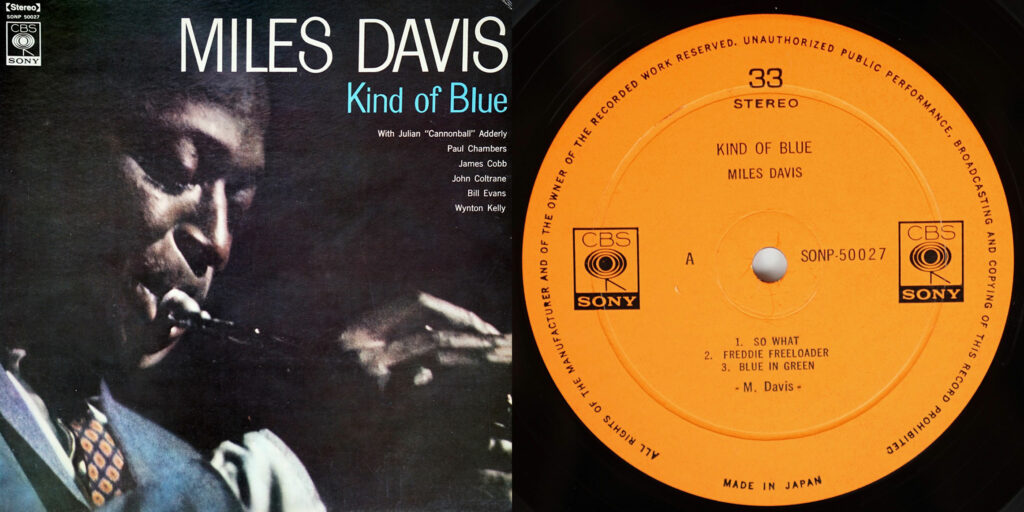
Never washed, NOS NM vinyl.
Before ultrasonic. No discernible surface noise, though plenty of tape hiss in the background. This is gorgeous sounding. Maybe just a tiny lack of focus on the horns at the start of “So What?” Drums/cymbals beautifully lifelike, lots of decay. Trumpet sits a bit far in the mix, bit of softness to it. Hard to imagine that left-channel sax solo sounding any better. Hard to find anything to fault in “Freddie Freeloader” — crisp cymbals, percussive piano. Bass is pretty buried, I guess. “Blue in Green,” too — hard to imagine it sounding better than this, especially the saxes. The bass is pretty buried again, but that’s all…
Washed 2 cycles, distilled bath, dried in AD. Still no surface noise. Definitely no lack of focus on the horns in “So What?” Bass beautifully clear. Drums unbelievably beautiful, especially the cymbal. There’s no way it was that good before washing. Trumpet still sits back in the mix, is slightly soft. The cymbals, though: definitely on another level. I’m hearing someone wheezing in the left channel I’ve never heard before. Added clarity to the sax; newly penetrating quality. Bass a bit more palpable on “Freddie Freeloader,” and the drums and horns seem similarly clearer. In “Blue in Green,” again, the bass seems in clearer focus, and the brushed snare a little more detailed, maybe? Another definite 5-10% bump.
So, yes: more evidence of improved sound quality.
Next steps
Whewwww. That, as they say, was a lot. The next step should be to take a few breaths.
I’ll do that — and then I’ll get right back to it. My next step is a more conventional one: I’ll swap my venerable and beloved Hercules II in a Mose box for a Linn Lingo 4 motor/PSU. This should be a big upgrade, though I’ve always been a bit skeptical of the effects of motors and PSUs. But given how much better my system has gotten in such a short time with just a few upgrades, I will absolutely not be surprised if it makes things sound even better.
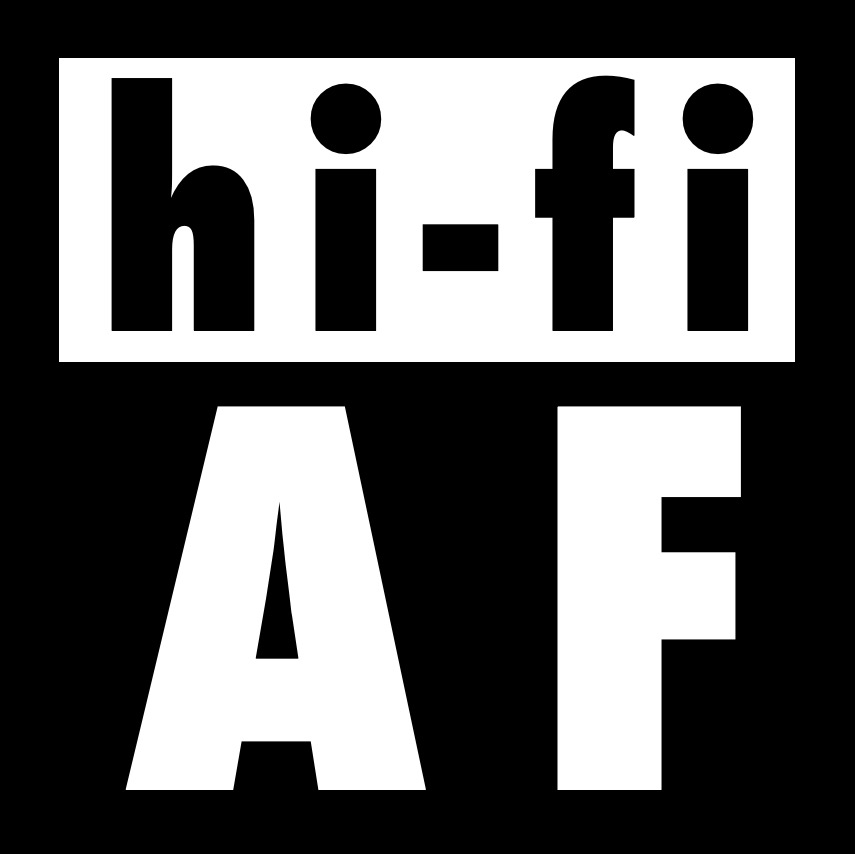
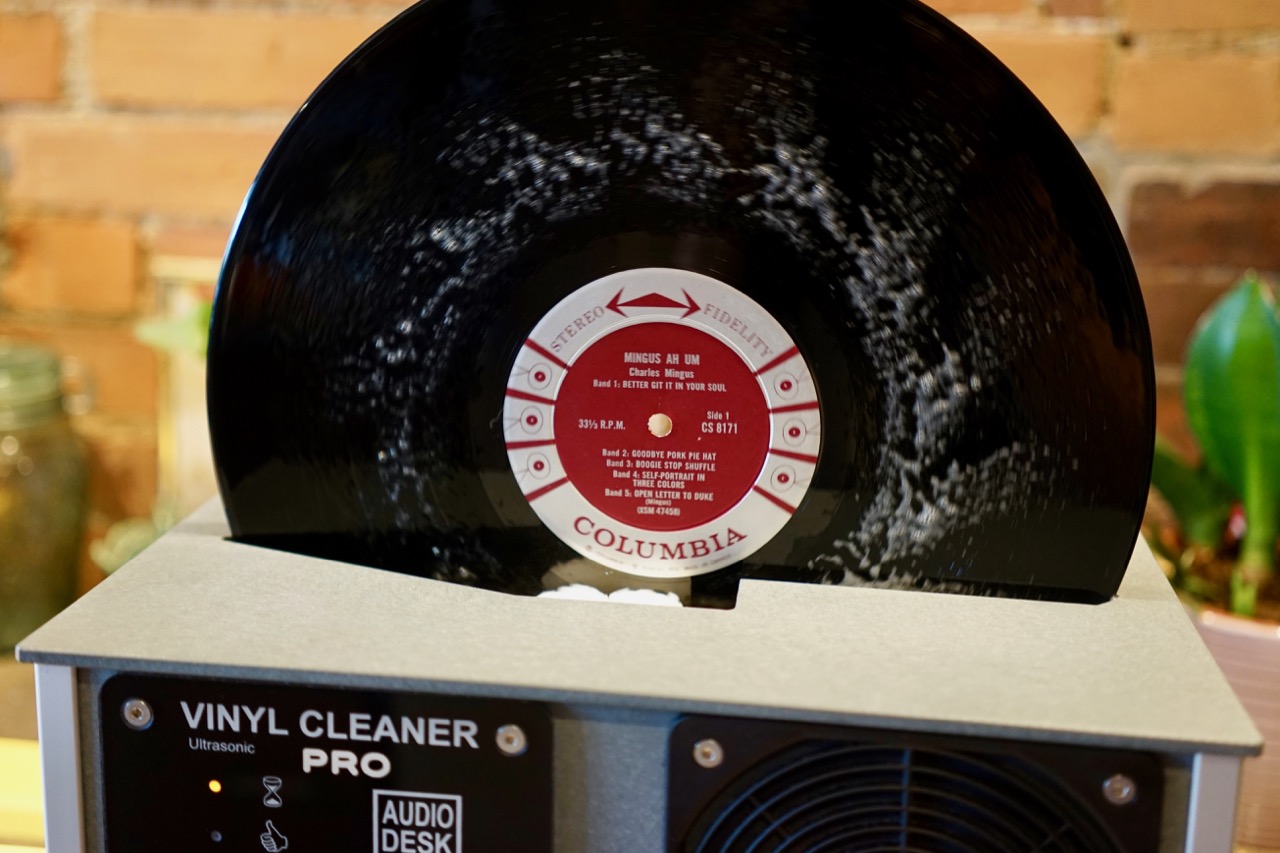
1 Comment
Join the discussion and tell us your opinion.
Most your your findings regarding US cleaning mirror my experiences. I heard improvements, ranging from subtle to substantial with all LPs cleaned via US. My process is 4 step: 1) Spin Clean as a pre cleaner to remove surface dirt and loosen embedded dirt. 2) US clean in a diy tank- Chinese tank and Vinyl Spinner LP holder, for 15 min at 0.33 RPM (5 total revolutions), at 30′ C temperature, using “Rushton’s” cleaning formual 3) Distilled rinse 4) Vac Dry using a Nitty Gritty machine. I note that you found debris in the bottom of your US tank, after several previous SC cycles. I have the same effluent in my US tank after a few LPs. I surmise this to be dirt etc not removed by the SC alone. Before US cleaning, many supposedly clean LPs exhibited a low level whoosshh-shhhhhh sound behind the music and between tracks. Post US cleaning, many LPs are completely or near completely silent, with a total absence of the whooosshh-shhhh sound. My theory is that over time, a microscopic layer of grunge becomes chemically bonded to the grooves of an LP. This layer obscures the leading edges of transients, and overwhelms low level and subtle soundstage cues..the air around people and instruments, the extreme harmonics of brass and string instruments for example. Post US cleaning this layer is removed, and all of the previously unheard low level detail is now easy to discern. The only real difference between your process and mine is opinions regarding efficacy of vacuum cleaning. I find vacuum cleaning a crucial last step to remove all vestiges of water and suspended dirt. I like your site, and LP comparisons. Keep up the good work !